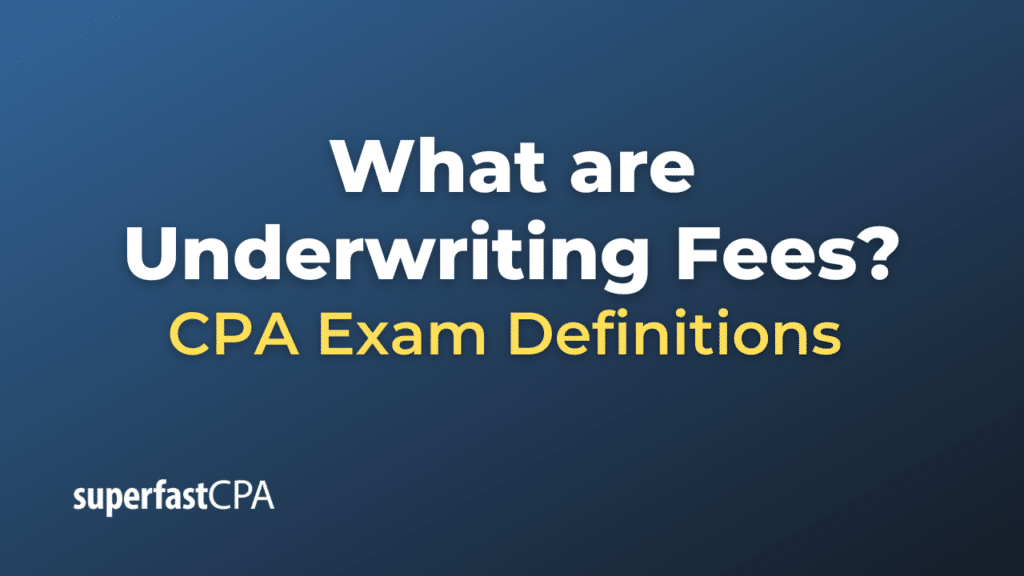Underwriting Fees
Underwriting fees are charges collected by underwriters for their services in assessing and assuming risk. These fees can vary widely depending on the type of underwriting and the specifics of the individual transaction. Here’s a look at how underwriting fees come into play in different sectors:
Insurance Underwriting
In the insurance industry, the concept of an “underwriting fee” is generally less common because the cost of underwriting is often integrated into the premium that the policyholder pays. However, some insurance companies may charge a nominal underwriting fee to cover administrative costs associated with evaluating and issuing a new policy.
Loan Underwriting
For loans, such as mortgages or business loans, underwriting fees (also sometimes called “origination fees”) are often charged to cover the cost of evaluating the creditworthiness of the borrower and processing the loan. These fees can vary but are often a percentage of the loan amount. They are generally paid at the closing of the loan transaction.
Securities Underwriting
In the case of securities underwriting, such as when a company goes public or issues bonds, underwriting fees are usually a percentage of the gross proceeds of the securities issuance. The fees compensate the investment bank for its due diligence, risk assumption, and efforts to sell the securities to investors. These fees can be substantial, running from less than 1% to as high as 7% or more of the total securities offering, depending on the complexity and risk associated with the issuance.
Structure and Terms
The structure and terms of underwriting fees can vary:
- Flat Fees: A fixed amount irrespective of the size or complexity of the transaction.
- Percentage-Based: A percentage of the total value of the transaction or the amount being underwritten.
- Sliding Scale: The fee varies based on the size or complexity of the transaction, often decreasing as the amount underwritten increases.
- Retainer and Success Fees : Especially in complex or high-risk transactions, an initial retainer may be charged along with a “success fee” if the underwriting is successfully completed.
Importance of Disclosure
Underwriting fees are generally disclosed upfront in the agreement between the underwriter and the client, and in the case of securities underwriting, they are also disclosed in the offering documents. Transparency is essential for ensuring that all parties understand the costs involved.
In summary, underwriting fees are a critical revenue stream for financial institutions involved in underwriting services. These fees are designed to compensate for the risk, effort, and expertise required in evaluating and facilitating financial transactions.
Example of Underwriting Fees
Let’s take examples from loan underwriting and securities underwriting to illustrate how underwriting fees work.
Loan Underwriting Example
Scenario : Amanda is applying for a mortgage loan of $300,000 to buy a house. The bank charges an underwriting fee of 1% of the loan amount.
Calculation:
- Underwriting Fee = 1% of $300,000
- Underwriting Fee = $3,000
Outcome:
Amanda would need to pay a $3,000 underwriting fee, typically at the closing of the mortgage transaction. This fee compensates the bank for evaluating her creditworthiness and processing the loan.
Securities Underwriting Example
Scenario: GreenTech Inc. is a renewable energy company looking to go public through an initial public offering (IPO). The company wants to raise $100 million. The investment bank that agrees to underwrite the IPO charges a 5% underwriting fee.
Calculation:
- Underwriting Fee = 5% of $100 million
- Underwriting Fee = $5 million
Outcome:
The investment bank would collect a $5 million underwriting fee from the gross proceeds of the IPO. This fee compensates the investment bank for its due diligence, marketing efforts, and the risk it takes in underwriting the new shares.
Notes
- In Amanda’s case, the fee might be paid at closing or rolled into the total loan amount, depending on the terms agreed upon. This fee is generally non-refundable, even if Amanda decides not to proceed with the loan after the underwriting process has begun.
- In the GreenTech Inc. example, the underwriting fee is typically deducted directly from the proceeds of the IPO, so the net funds received by GreenTech would be $95 million ($100 million – $5 million).
These examples illustrate how underwriting fees are calculated and how they can vary based on the type of transaction. They serve as a compensation to the underwriters for their services and the risks they assume.













